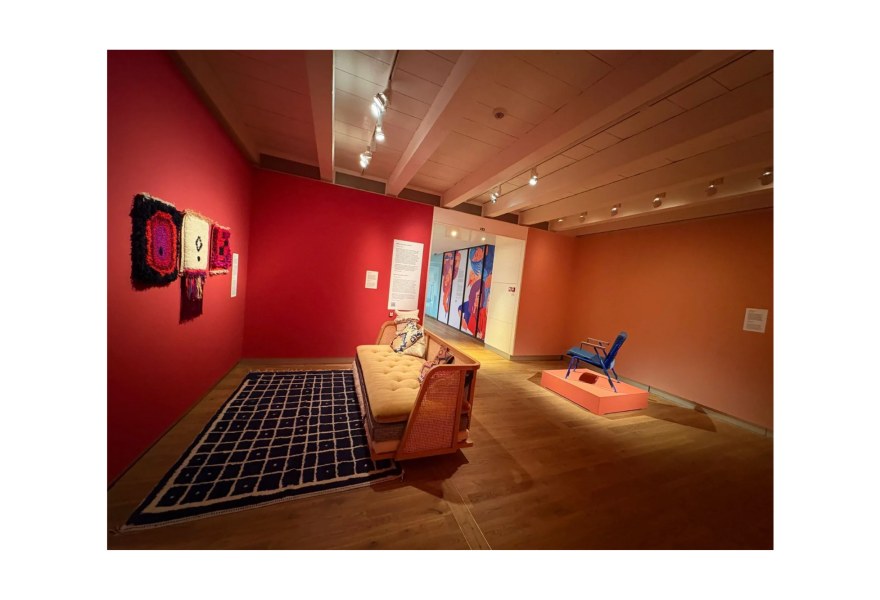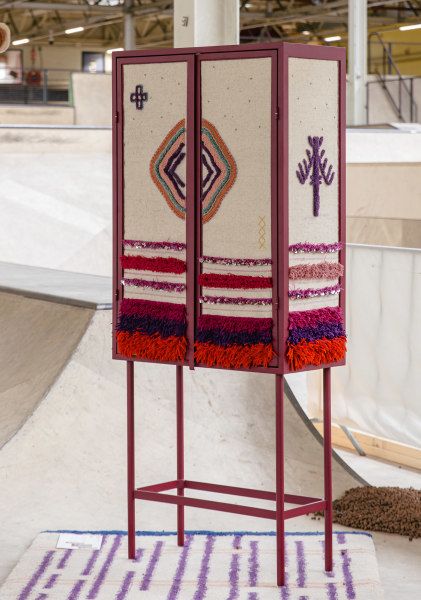04 april 2025, Flor Linckens
Tradition as a form of activism: Mina Abouzahra at the Amsterdam Museum
Until 1 June, the Amsterdam Museum is presenting work by designer and artist Mina Abouzahra as part of the exhibition 'Women of Amsterdam - an ode'. With her installation "1,5 woman", Abouzahra, represented by Rademakers Gallery, pays tribute to the strength and interconnectedness of women. Among the works on view is a tapestry she created in collaboration with Amazigh women from a Moroccan weaving cooperative. The exhibition celebrates the impact of women on the city of Amsterdam in honour of its 750th anniversary, recognising those who deserve a place in our collective memory.
As a Dutch-Moroccan designer who grew up between two cultures, Abouzahra knows better than most what it means to navigate multiple worlds. That layered cultural background forms the foundation of her practice. Her rugs, furniture, installations and interiors bring together craft, art and design. The handwork of Moroccan weavers meets the clean lines and formal language of contemporary Dutch design. Her work is grounded in years of thorough historical and material research and always arises from collaboration.
The installation "1,5 woman", currently on display at the Amsterdam Museum, consists of a wall tapestry, the chair "Hieja", the sofa "Goity" (meaning "little sister") and the triptych "Fruits of the Loom". The title refers to the Amazigh expression "one and a half woman", used to describe a woman of extraordinary strength. The installation weaves together craftsmanship and heritage with stories of resilience and female solidarity that transcend generations.
Abouzahra’s fascination with Moroccan craftsmanship began during her furniture design studies in Amsterdam. While completing a year-long internship in southern Morocco, she was deeply impressed by the symbolism, colours and techniques that have been passed down there for centuries. She was also struck by the physically demanding nature of the work. Since then, she has worked closely with female artisans in Morocco. Working under the name of her studio, she works with these women to create unique, handcrafted rugs. These collaborations are rooted in mutual respect and knowledge exchange, but they also address economic justice. Women in this sector earn on average only twenty cents an hour for their labour, despite producing a globally beloved and highly profitable product. Abouzahra aims to revalue this craft, both culturally and financially, and hopes to empower these women in the process.
Through projects like 'One Square Meter Berber', she brings the often invisible labour of these women to light. Every rug tells a story: of origin, of family ties, of different stages in life. They are woven by women who are often unable to read or write, but who find other ways to pass on their histories: through patterns, narratives and techniques handed down across generations. In an interview with Residence magazine, Abouzahra said: “Each region has its own rug, its own motifs, and each one tells a specific story about the tribe, the family or the life phase of the woman who made it. It’s a form of self-expression for women who often cannot read or write. It’s also a social ritual. The women gather to knot, exchange news and support one another. It’s intimate, warm and communal.”
More and more young women, however, are opting for better-paid careers, leading to the slow disappearance of knowledge and techniques that have been handed down by generations of women. It’s a global phenomenon: traditional crafts are under pressure everywhere, with the loss of local identity looming. That is why Abouzahra advocates for formal recognition and protection of these crafts, including through regulation and fair compensation. Only when women become aware of the value of their work, and of their role as keepers of tradition, can their craft be protected in a meaningful and lasting way.
In recent years, Abouzahra has also collaborated with Dutch artists and designers such as Bertjan Pot, Wieki Somers and Amie Dicke. Her work is part of the collections of the Centraal Museum, the Cobra Museum, the Jewish Historical Museum, the Wereldmuseum and the Muiderslot. She was awarded a Dutch Creativity Award, yet her main motivation remains building bridges: between craft, design and art, between past and present, between the Netherlands and Morocco. For her, design is more than aesthetics; it is a form of activism, a way to connect and visualise the stories that often remain unseen.
In the context of 'Women of Amsterdam - an ode', her work takes on an added layer of meaning. It reflects not only her personal connection to Amsterdam but also her commitment to women who are often forgotten elsewhere. By placing their work in a museum setting, Abouzahra contributes to a more inclusive narrative of the city and its people. With "1,5 woman", she invites us to reflect on the quiet power of women, on what they pass on, shape and preserve: in Amsterdam and far beyond.



